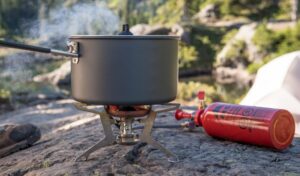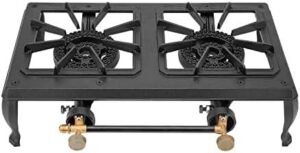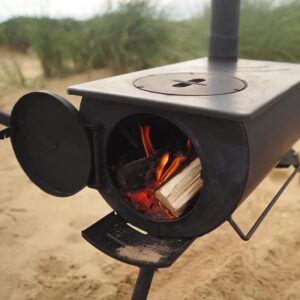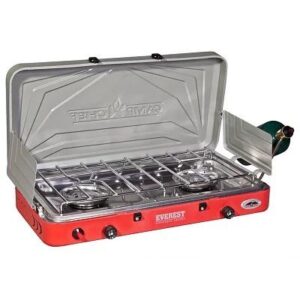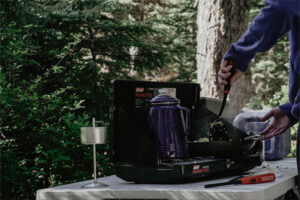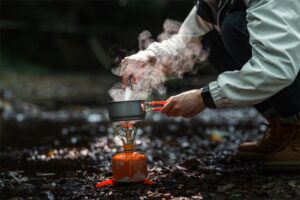
Types of Camping Stoves: Backpacking vs Car Camping Stoves
Before you begin shopping for a camp stove, ask yourself: “Am I ever going to want to carry this stove in my backpack?” There are two varieties of camp stoves: backpacking stoves, which are compact and light enough to fit in an overnight bag, and base camp or car camping stoves, which are designed to be transported a short distance from your car to your campsite. It’s virtually hard to locate a real crossover stove, and while you can use a backpacking stove at basecamp, you won’t want to carry your basic two-burner miles into the bush.
Backpacking stoves are compact and lightweight, frequently the size of a water bottle, including the pot for boiling water. That makes them incredibly portable, but they don’t produce much heat, which is difficult to manage. This means they’re best suited to heating water for coffee, dried foods, or porridge. You’re not really “cooking” with a hiking stove; you’re just trying to bring water to boil as quickly as possible. So, if you’re not spending the night deep in the bush and need a stove to cook for a large group, a backpacking stove won’t suffice, and you should consider a larger basecamp stove.
Basecamp stoves are stoves that are intended to be used when automobile camping. They’re substantially larger and more suited for cooking up some backcountry gourmet. These stoves evoke memories of the very ubiquitous forest green two-burner stove that many people grew up on. They’re light enough that you can carry them a few hundred yards to the campground, yet they weigh more than many ultralight trekkers’ whole packs. They’re more like a backyard barbecue or a gas range than a camping stove. Many of these stoves feature many burners, making it easier to control heat. This implies that you’ll be simmering and sautéing rather than boiling. You also have the heating ability to prepare a large number of meals for many more people. Most individuals prefer to car camp with a basecamp stove. So, consider the sorts of camping trips you enjoy: are they usually multi-day expeditions deep in the wilderness, or do you like to rest in nature closer to your car? If you fall somewhere in the center, we recommend shopping for a budget backpacking stove as well as a lower-cost basecamp stove. Sure, you can use a backpacking stove while vehicle camping, but your cooking options will be severely limited.
Backpacking Fuel stoves:
Canister camping stoves
Backpackers choose canister stoves because of their lightweight, streamlined design, and convenience of use. Essentially, the stove screws straight into a tiny canister containing compressed fuel, such as butane or propane, and you’re good to go. These stoves are perfect for cooking basic foods like oatmeal and quick meals, which are added to boiling water in a tiny saucepan. The disadvantages of these stoves are that they don’t perform well in cold weather, and while the fuel canisters are recyclable, they are not reusable.
Liquid and multifuel camping stoves
Liquid fuel stoves include a line that connects to a reusable canister storing liquid fuel like white gas or kerosene. As a result, these stoves are slightly less compact and heavier than canister stoves, and they require priming by pumping the fuel bottle to function. Despite their extra weight, these stoves provide several advantages. They perform better at high elevations and in low climates, provide greater temperature control, and are better for group cooking than canister stoves. They also frequently function with a variety of fuels, making them more versatile for travel.
Double burner camping stoves
If you’re going vehicle camping or only need a stove for a day at the beach, you don’t have to worry about size or weight, and you might want to consider a twin burner stove. These stoves resemble portable barbecue grills and are often constructed of stainless steel. They operate on propane. The main advantage of a twin burner stove is that it allows you to cook two pots or frying pans at the same time, allowing you to prepare more elaborate recipes for more people. When you’re finished, just fold it up and use the carrying handle to take it to the car.
Wood burning camping stoves
Another form of camping stove that is becoming popular is the wood-burning stove, which is available in both backpacking and vehicle camping models. These stoves use natural materials such as twigs and leaves, eliminating the need to purchase fuel (although they can also run on wood pellets or charcoal briquettes), and give you a sense of what it’s like to cook over an open fire with much more control and simplicity. They’re fairly simple to operate, and if you’re camping somewhere where you can’t have an open fire, you might be allowed to use your stove. The main disadvantage is that, like with campfires, you may have difficulties locating dry kindling if you’re camping in the rain.
Basecamp or Car Camping Stoves
There are several alternatives for car camping stoves, ranging from simple two-burner systems to burners comparable to those seen in restaurants. As with most camping gear, you’ll pick based on your camping style and the characteristics of your normal campground. Most basecamp stoves are powered by propane, either in the form of smaller, green camping canisters or larger canisters used in home grills. Some types are also adaptable to other fuel sources. When selecting a vehicle camping stove, consider three main factors: whether you need a freestanding device or will cook on a table, the number and size of burners, and the number of BTUs produced per burner.
Tabletop vs Freestanding Camping Stoves
There are two varieties of basecamp stoves: tabletop camping stoves, which are smaller and lighter and meant to be used on a picnic or camping table, and freestanding units, which resemble a home grill. If you’re typically camping at established sites with tables, a tabletop stove is great; but, freestanding choices free up tablespace for prep work and meals, or allow you to cook in locations without tables. Another alternative is to pack a lightweight folding table for your tabletop stove, allowing you to use it anywhere. Freestanding units often have bigger burners, but tabletop ones remain rather small.

